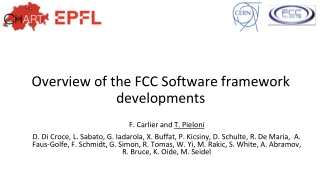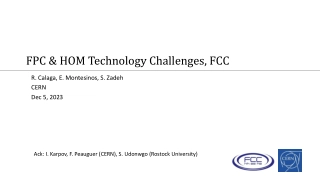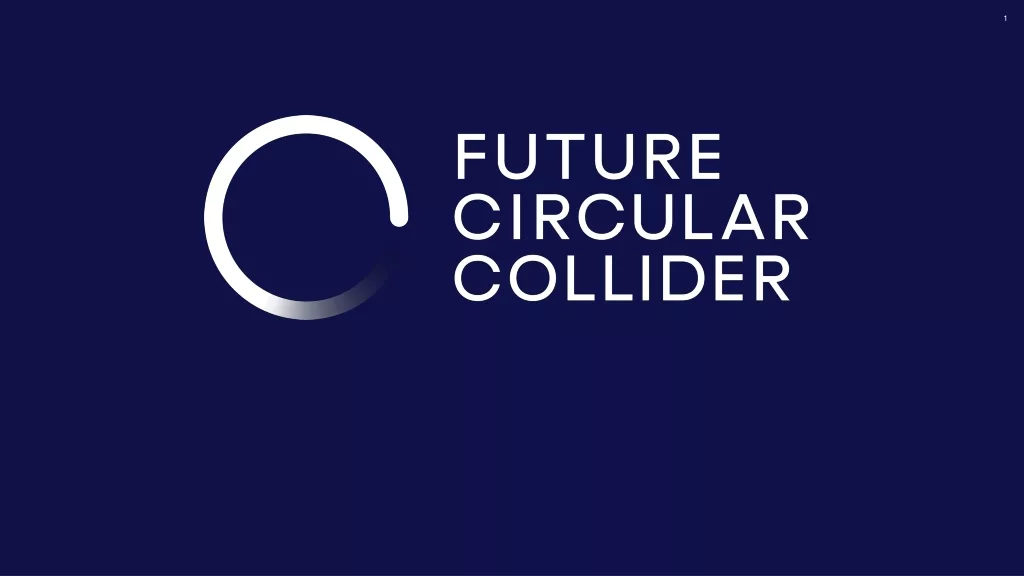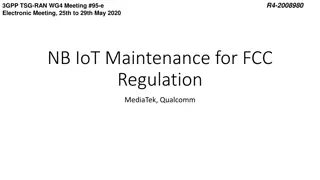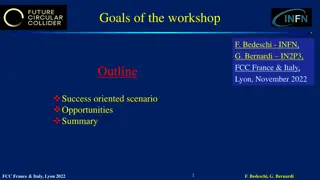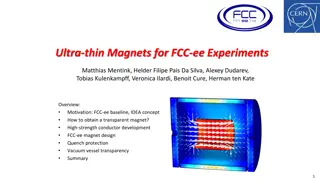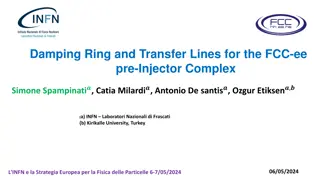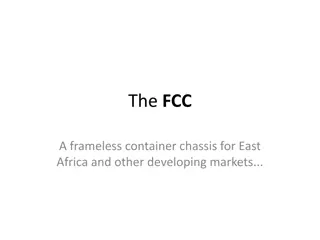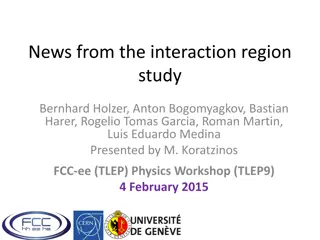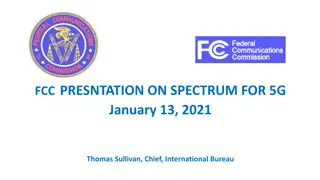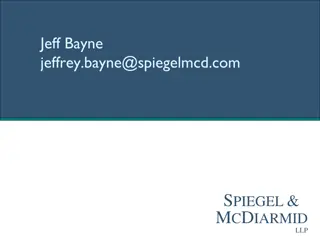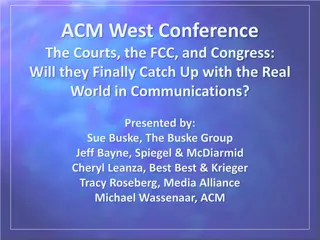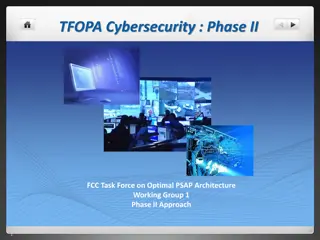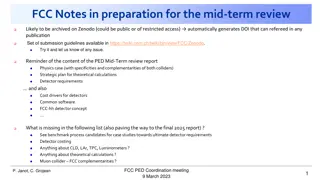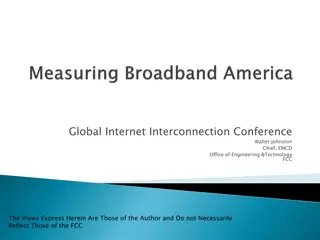
Parameter Optimization for Luminosity Enhancement in High-Energy Colliders
Explore Dmitry Shatilov's presentation on parameter choices and optimization strategies for maximizing luminosity in upcoming high-energy collider experiments. Discover key considerations, such as beam-beam limits, beamstrahlung effects, and coherent instabilities, to achieve optimal performance.
Download Presentation

Please find below an Image/Link to download the presentation.
The content on the website is provided AS IS for your information and personal use only. It may not be sold, licensed, or shared on other websites without obtaining consent from the author. If you encounter any issues during the download, it is possible that the publisher has removed the file from their server.
You are allowed to download the files provided on this website for personal or commercial use, subject to the condition that they are used lawfully. All files are the property of their respective owners.
The content on the website is provided AS IS for your information and personal use only. It may not be sold, licensed, or shared on other websites without obtaining consent from the author.
E N D
Presentation Transcript
14 Sep 2022 / eeFACT2022 FCC-ee Parameter Choice for Luminosity Optimization Dmitry Shatilov Thanks to: T. Charles, K. Ohmi, K. Oide, L.V. Riesen-Haupt, F. Yaman, Y. Zhang, F. Zimmermann, M. Zobov
2 14 Sep 2022 / eeFACT2022 D. Shatilov Outline The main points on which the choice of parameters and their optimization was based Parameter changes after CDR Problems: lattice errors and misalignments 2 IPs vs. 4 IPs Next steps
3 14 Sep 2022 / eeFACT2022 D. Shatilov Basic Equations x = e- tg z Piwinski angle: + e Li 2 x x + 2 = * y Length of overlap: x L z i 2 1 1, 1 z 2 x I tot y = L R Luminosity: hg * y 2 er Collision scheme with large Piwinski angle e linear density * y * y N r N r There is no sense to optimize the luminosity per bunch (or per collision). Attention should only be paid to y. zis one of the most variable parameters: it depends on many factors, including the bunch population Np. Accordingly, Npshould be adjusted to obtain the desired y. The number of bunches nb 1/Np. We don't need to worry about this (except for Z) since the range of valid values is quite wide. p e p = e y 2 + 2 1 1, 1 z y y x The beam-beam limit in the Crab Waist collision scheme can be high, but to obtain it, a small vertical emittance and a sufficiently high bunch linear density are required. The latter is an important parameter for collective instabilities and impedance-related issues, so this is another limitation.
4 14 Sep 2022 / eeFACT2022 D. Shatilov Beamstrahlung Bending radius in the field of the opposite bunch Equilibrium energy distribution surface density 45.6 GeV The factor of increasing the energy spread is higher at low energies. The explanation is that it depends on the ratio of the bending radii in the arcs (SR) and in the IPs (BS). N 1 p y y 0.002 * x * y min x z x With increasing energy, beta functions at IP should grow while yalmost does not change => increases. For low-energy colliders, minat the IP can be even smaller, but the effect of BS is negligible there, since the arc radius is much smaller than in the FCC. Bending radius is not constant along the trajectory, and it depends on the particle coordinates. = 3.5 0 E/ 0 All initial coordinates = 0, except y0= 2 y At 45.6 GeV, the energy loss due to BS is 0.31 MeV per IP, compared to 37 MeV in the arcs due to SR. 182.5 GeV / [mm-1] Long tails at ttbar are produced by single emitted BS photons. Here the ratio uc/ is important, which grows with . = 1.3 0 For asymmetry of the tails, an important parameter is the damping factor during the period of synchrotron oscillations. Therefore, asymmetry grows with . E/ 0 Distance to IP [mm] Momentum acceptance determines the maximum allowable critical energy of BS photons, which in turn is proportional to y (and hence luminosity). Critical energy of BS photons: uc 3/ y L
5 14 Sep 2022 / eeFACT2022 D. Shatilov Parameter Optimization at Z, WW and ZH Changes after CDR Coherent beam-beam instability (TMCI) Arc optics at Z and WW: 60 /60 => 90 /90 , long cell. This is needed to increase the momentum compaction factor and mitigate the coherent instabilities. Excited coherent modes are associated with synchro-betatron resonances: = Bunch shape at some turns 2 2 , m n m x z If is not too large, we can solve the problem by choosing + x / x The baseline scenario now assumes 4 IPs. In this case, at Z energy, it will be necessary to reduce x*from 15 to 10 cm. And it will affect the DA and momentum acceptance But, most likely, we will have to reduce the bunch population due to other problems, and then it will be possible to keep x*= 15 cm. The RF voltage at WW increased to 1 GV. This increases the synchrotron tune to 0.08, which is necessary for precise energy calibration by the resonant depolarization. 0.5 x z We are close to this requirement at ZH and are fulfilling it at ttbar. z / z An important parameter for this instability is the ratio x / z, which needs to be minimized. * p e x x x + * x N r N 2 r p = e ( ) 2 2 z 2 2 2 1 1, 1 Mitigation of instability: Decrease in x* 2) Increase in the momentum compaction factor (but there is a side effect: increased emittances) only at Z and WW 1) 3) Decrease in RF voltage only at Z At ZH energy no significant changes. 4) Proper choice of the working point
6 14 Sep 2022 / eeFACT2022 D. Shatilov Parameter Optimization at ttbar The major tool for increasing the lifetime is making larger. For flat beams, is inversely proportional to the surface charge density: Luminosity is limited by BS lifetime (single photon): 2 3 exp bs 2 2 L r i e N 1 p y y y L fine structure constant * y * y L x z i momentum acceptance (assuming ) * y iL bending radius of trajectories at the IP (this works for any ) Li length of interaction area We need to increase with large luminosity => small emittances (90 /90 short arc cell optics) and increase Li(i.e. x) and . Since xshould be small, xis controlled by which was increased to 1 m. This is the main difference in parameter optimization: at lower energies, must be minimized to mitigate coherent beam-beam instability. There is no such problem at ttbar, so x * y * x * x * becomes a free parameter. Asymmetrical momentum acceptance to match the actual energy distribution (K. Oide). Recent change: increasing yfrom 0.59 to 0.64 to move away from the main coupling resonance.
7 14 Sep 2022 / eeFACT2022 D. Shatilov Lattice Errors and Misalignments Misalignments and errors can lead to a significant decrease in the DA and momentum acceptance. This limits the luminosity per IP even in the case of ideal super-periodicity. The full beam-beam footprint from 2 or 4 IPs can cross a number of strong resonances, e.g. 1/2, 1/3, etc. The width of these resonances depends on the level of symmetry breaking, which depends on the magnitude of misalignments and the quality of corrections. Ways to solve the problem: improve the quality of corrections, and reduce the magnitude of misalignments (can be expensive!). Perhaps the increased accuracy of the alignment will be required only for some sections, and not for the entire ring this needs to be clarified. Error correction should consist of several stages: obtain a stable orbit and designed emittances, then enlarge the DA and momentum acceptance, and special attention must be paid to obtaining designed lattice parameters at the IPs and crab sextupoles (dedicated knobs at the IR). This work is ongoing and notable progress has been made recently. A realistic assessment of the beam dynamics, luminosity and lifetime is possible only in simulations, taking into account all errors, corrections and beam-beam effects.
8 14 Sep 2022 / eeFACT2022 D. Shatilov Footprint Size (machine resonances w/o beam-beam) Ideal lattice (4-fold symmetry) Seed 2, 1/4 of the ring Seed 2, 1/2 of the ring Seed 2, full ring Only the quarter ring footprint matters. For the whole ring, the footprint will be 4 times larger, but most of the resonances it cros- ses will be forbidden. A quarter of the ring is artificially repeated 4 times. New resonances appeared due to errors, but many remained forbidden due to symmetry. The half ring is artificially repeated 2 times. Two different quarters form a super period, which corresponds to a doubled footprint. And new resonances appeared. A realistic situation where there is no sym- metry between quarters, and accordingly all resonancesare allowed. Betatron tunes (footprint) Normalized betatron amplitudes
9 14 Sep 2022 / eeFACT2022 D. Shatilov 2 IPs vs. 4 IPs A layout designed for just 2 IPs is much simpler. Only two additional crossings in the straight sections are required, and such insertions in the arcs (in each quarter) will not be needed. Much more space will be available in the straight sections. Horizontal beta-function at Z-pole can be relaxed, since sper superperiod will be twice as much. Two-fold lattice symmetry is easier to achieve than four-fold. The 2 IPs option is more stable for fine tuning, the commissioning time will be shorter. But With the same total luminosity, the increase in energy spread due to BS will be less at 4 IPs. Since the luminosity will be limited mainly by the energy spread, it will be higher at 4 IPs. How much higher depends on what footprint size is achievable, taking into account the symmetry breaking between superperiods. For more reasonable estimates and comparison (2 vs. 4), modeling is needed taking into account all the details. Work in progress
10 14 Sep 2022 / eeFACT2022 D. Shatilov Next Steps We should try to improve the situation with misalignments and imperfections More sophisticated correction algorithms to mitigate DA reduction. Mechanical movers for all sextupoles to reduce the orbit offsets relative to the center of sextupoles to several microns. High resolution BPMs are required. What will be the cost? Some new ideas Perform simulations to understand how much luminosity can be achieved with different levels of misalignments and errors, and at what cost. To do this, it is necessary to have knobs for controlling the lattice and orbit at all IPs, betatron phase advances between IPs, etc. Some progress has been made here recently. These simulations must be performed for all energies, 2 and 4 IPs. Only after that it will be possible to give reasonable recommendations about the optimal number of IPs and the achievable luminosity.
11 14 Sep 2022 / eeFACT2022 D. Shatilov Conclusion The main parameters of FCC-ee (lattice, RF, beta-functions at the IP, etc.) are more or less defined. Further optimization is mainly related to misalignments and errors, and it will affect only the bunch population Np(and, accordingly, the number of bunches nband luminosity). There are many other things that depend on Npand nb. For some of them (i.e. electron clouds and ion instabilities, mainly at Z), an increase in Npand, consequently, a decrease in nbare beneficial. For impedance-related phenomena, the opposite is true. In any case, we need to have large flexibility in these parameters. Perhaps as we resolve the current issues, new ones will be discovered. Parameter optimization is a very interesting and exciting (and maybe endless) process, the work continues...

